Business and Information Technology: IoT Impact on Business Processes
VerifiedAdded on 2022/08/21
|7
|1642
|11
Report
AI Summary
This report analyzes the significant impact of the Internet of Things (IoT) on business operations and service quality. It explores how organizations leverage IoT to enhance customer satisfaction, expand infrastructure, and improve business process management. The report delves into the benefits of IoT, including improved customer experience, increased productivity, and cost-effectiveness, while also addressing challenges such as compatibility issues and security concerns. Furthermore, it examines the impact of IoT on both internal and external users, highlighting enhanced communication, automated processes, and data-driven decision-making. The conclusion emphasizes IoT's role in transforming business services, particularly in decision-making and productivity, and the importance of addressing the challenges associated with its implementation. The report references various academic sources to support its findings.
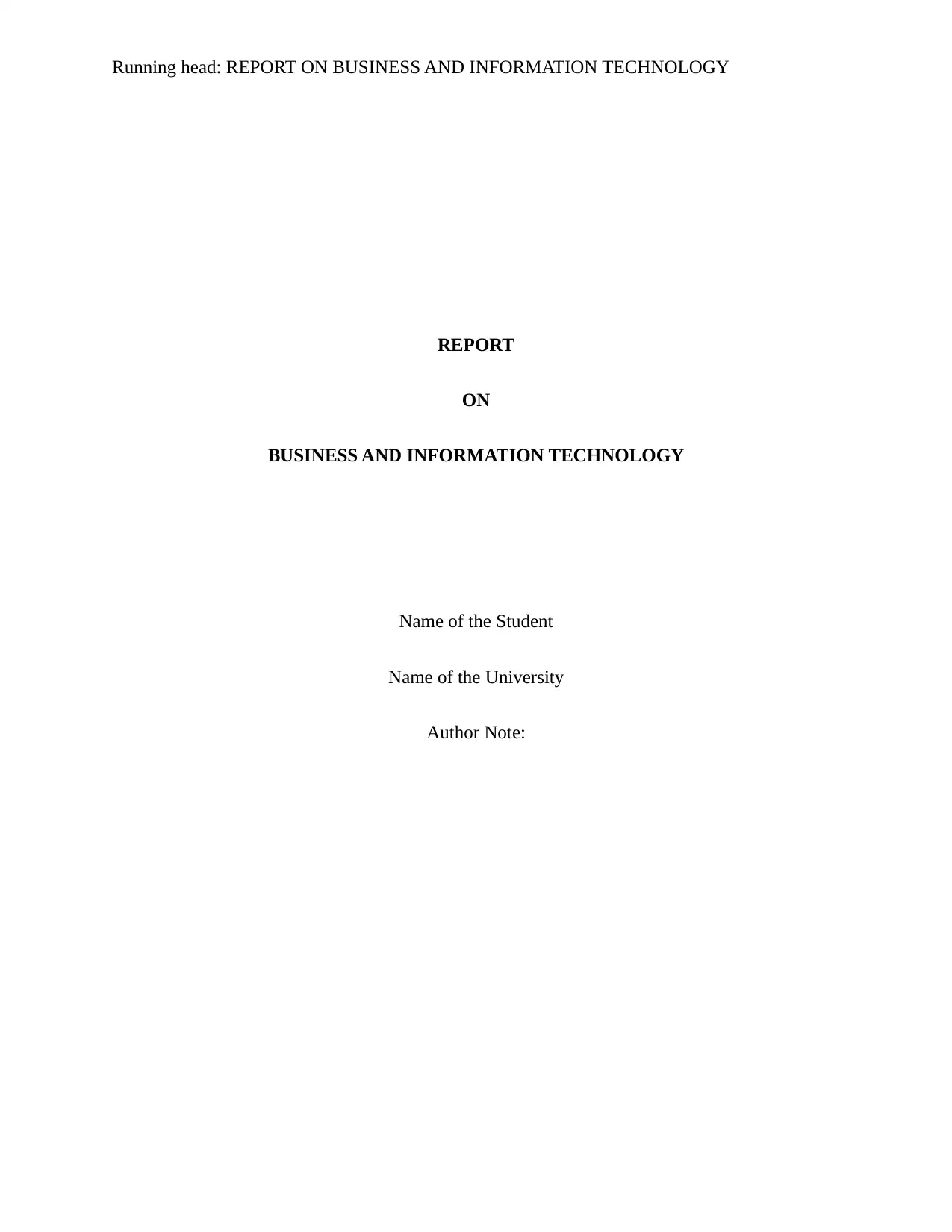
Running head: REPORT ON BUSINESS AND INFORMATION TECHNOLOGY
REPORT
ON
BUSINESS AND INFORMATION TECHNOLOGY
Name of the Student
Name of the University
Author Note:
REPORT
ON
BUSINESS AND INFORMATION TECHNOLOGY
Name of the Student
Name of the University
Author Note:
Paraphrase This Document
Need a fresh take? Get an instant paraphrase of this document with our AI Paraphraser
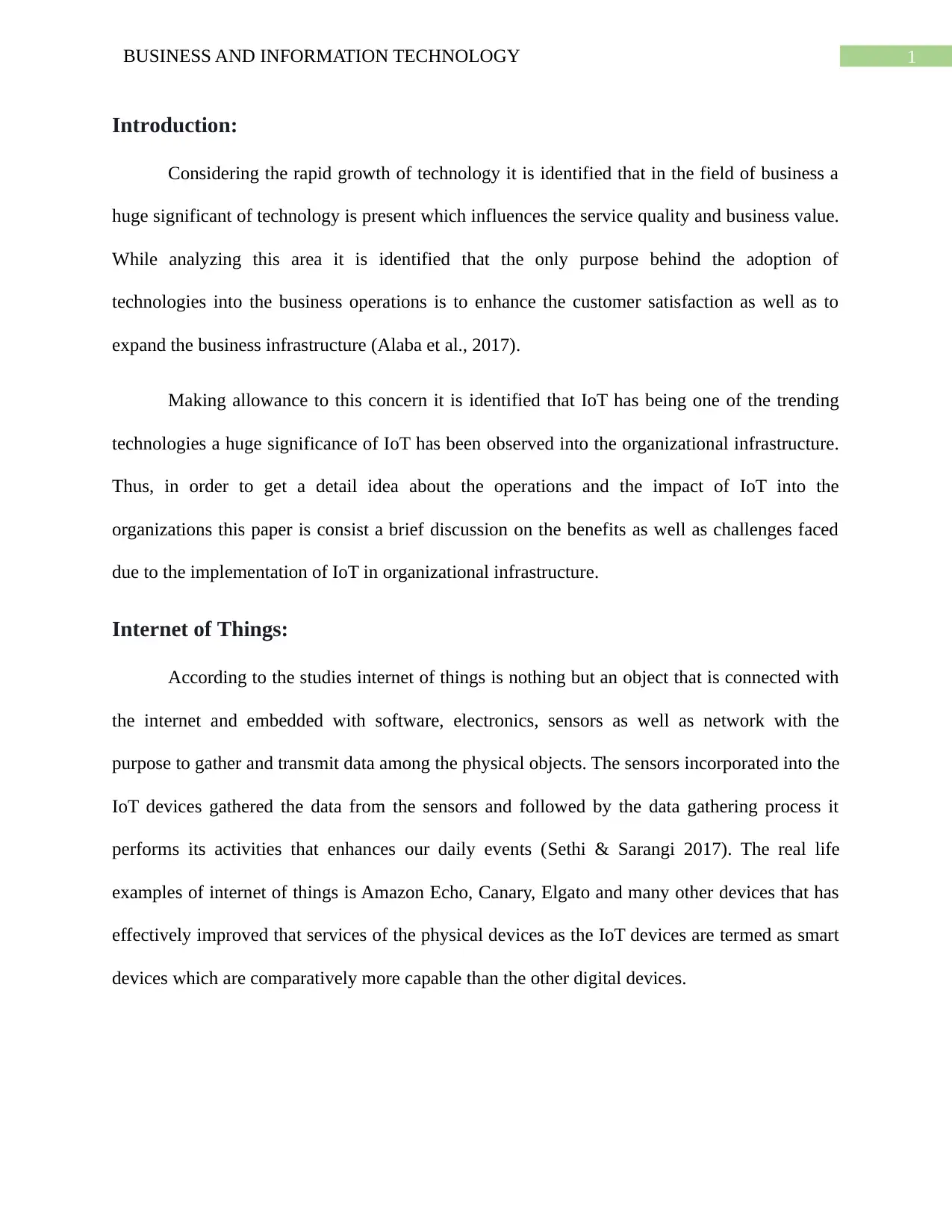
1BUSINESS AND INFORMATION TECHNOLOGY
Introduction:
Considering the rapid growth of technology it is identified that in the field of business a
huge significant of technology is present which influences the service quality and business value.
While analyzing this area it is identified that the only purpose behind the adoption of
technologies into the business operations is to enhance the customer satisfaction as well as to
expand the business infrastructure (Alaba et al., 2017).
Making allowance to this concern it is identified that IoT has being one of the trending
technologies a huge significance of IoT has been observed into the organizational infrastructure.
Thus, in order to get a detail idea about the operations and the impact of IoT into the
organizations this paper is consist a brief discussion on the benefits as well as challenges faced
due to the implementation of IoT in organizational infrastructure.
Internet of Things:
According to the studies internet of things is nothing but an object that is connected with
the internet and embedded with software, electronics, sensors as well as network with the
purpose to gather and transmit data among the physical objects. The sensors incorporated into the
IoT devices gathered the data from the sensors and followed by the data gathering process it
performs its activities that enhances our daily events (Sethi & Sarangi 2017). The real life
examples of internet of things is Amazon Echo, Canary, Elgato and many other devices that has
effectively improved that services of the physical devices as the IoT devices are termed as smart
devices which are comparatively more capable than the other digital devices.
Introduction:
Considering the rapid growth of technology it is identified that in the field of business a
huge significant of technology is present which influences the service quality and business value.
While analyzing this area it is identified that the only purpose behind the adoption of
technologies into the business operations is to enhance the customer satisfaction as well as to
expand the business infrastructure (Alaba et al., 2017).
Making allowance to this concern it is identified that IoT has being one of the trending
technologies a huge significance of IoT has been observed into the organizational infrastructure.
Thus, in order to get a detail idea about the operations and the impact of IoT into the
organizations this paper is consist a brief discussion on the benefits as well as challenges faced
due to the implementation of IoT in organizational infrastructure.
Internet of Things:
According to the studies internet of things is nothing but an object that is connected with
the internet and embedded with software, electronics, sensors as well as network with the
purpose to gather and transmit data among the physical objects. The sensors incorporated into the
IoT devices gathered the data from the sensors and followed by the data gathering process it
performs its activities that enhances our daily events (Sethi & Sarangi 2017). The real life
examples of internet of things is Amazon Echo, Canary, Elgato and many other devices that has
effectively improved that services of the physical devices as the IoT devices are termed as smart
devices which are comparatively more capable than the other digital devices.
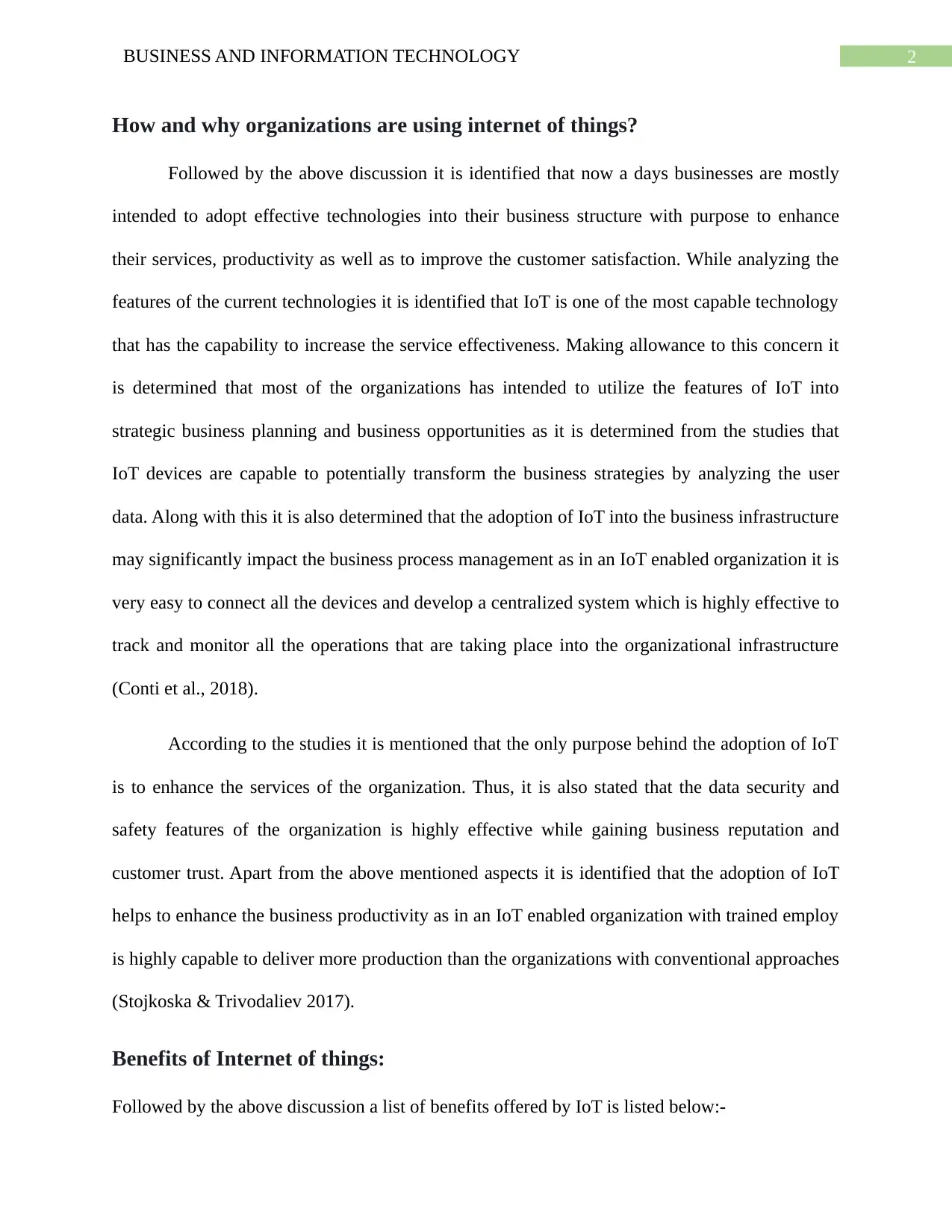
2BUSINESS AND INFORMATION TECHNOLOGY
How and why organizations are using internet of things?
Followed by the above discussion it is identified that now a days businesses are mostly
intended to adopt effective technologies into their business structure with purpose to enhance
their services, productivity as well as to improve the customer satisfaction. While analyzing the
features of the current technologies it is identified that IoT is one of the most capable technology
that has the capability to increase the service effectiveness. Making allowance to this concern it
is determined that most of the organizations has intended to utilize the features of IoT into
strategic business planning and business opportunities as it is determined from the studies that
IoT devices are capable to potentially transform the business strategies by analyzing the user
data. Along with this it is also determined that the adoption of IoT into the business infrastructure
may significantly impact the business process management as in an IoT enabled organization it is
very easy to connect all the devices and develop a centralized system which is highly effective to
track and monitor all the operations that are taking place into the organizational infrastructure
(Conti et al., 2018).
According to the studies it is mentioned that the only purpose behind the adoption of IoT
is to enhance the services of the organization. Thus, it is also stated that the data security and
safety features of the organization is highly effective while gaining business reputation and
customer trust. Apart from the above mentioned aspects it is identified that the adoption of IoT
helps to enhance the business productivity as in an IoT enabled organization with trained employ
is highly capable to deliver more production than the organizations with conventional approaches
(Stojkoska & Trivodaliev 2017).
Benefits of Internet of things:
Followed by the above discussion a list of benefits offered by IoT is listed below:-
How and why organizations are using internet of things?
Followed by the above discussion it is identified that now a days businesses are mostly
intended to adopt effective technologies into their business structure with purpose to enhance
their services, productivity as well as to improve the customer satisfaction. While analyzing the
features of the current technologies it is identified that IoT is one of the most capable technology
that has the capability to increase the service effectiveness. Making allowance to this concern it
is determined that most of the organizations has intended to utilize the features of IoT into
strategic business planning and business opportunities as it is determined from the studies that
IoT devices are capable to potentially transform the business strategies by analyzing the user
data. Along with this it is also determined that the adoption of IoT into the business infrastructure
may significantly impact the business process management as in an IoT enabled organization it is
very easy to connect all the devices and develop a centralized system which is highly effective to
track and monitor all the operations that are taking place into the organizational infrastructure
(Conti et al., 2018).
According to the studies it is mentioned that the only purpose behind the adoption of IoT
is to enhance the services of the organization. Thus, it is also stated that the data security and
safety features of the organization is highly effective while gaining business reputation and
customer trust. Apart from the above mentioned aspects it is identified that the adoption of IoT
helps to enhance the business productivity as in an IoT enabled organization with trained employ
is highly capable to deliver more production than the organizations with conventional approaches
(Stojkoska & Trivodaliev 2017).
Benefits of Internet of things:
Followed by the above discussion a list of benefits offered by IoT is listed below:-
⊘ This is a preview!⊘
Do you want full access?
Subscribe today to unlock all pages.

Trusted by 1+ million students worldwide
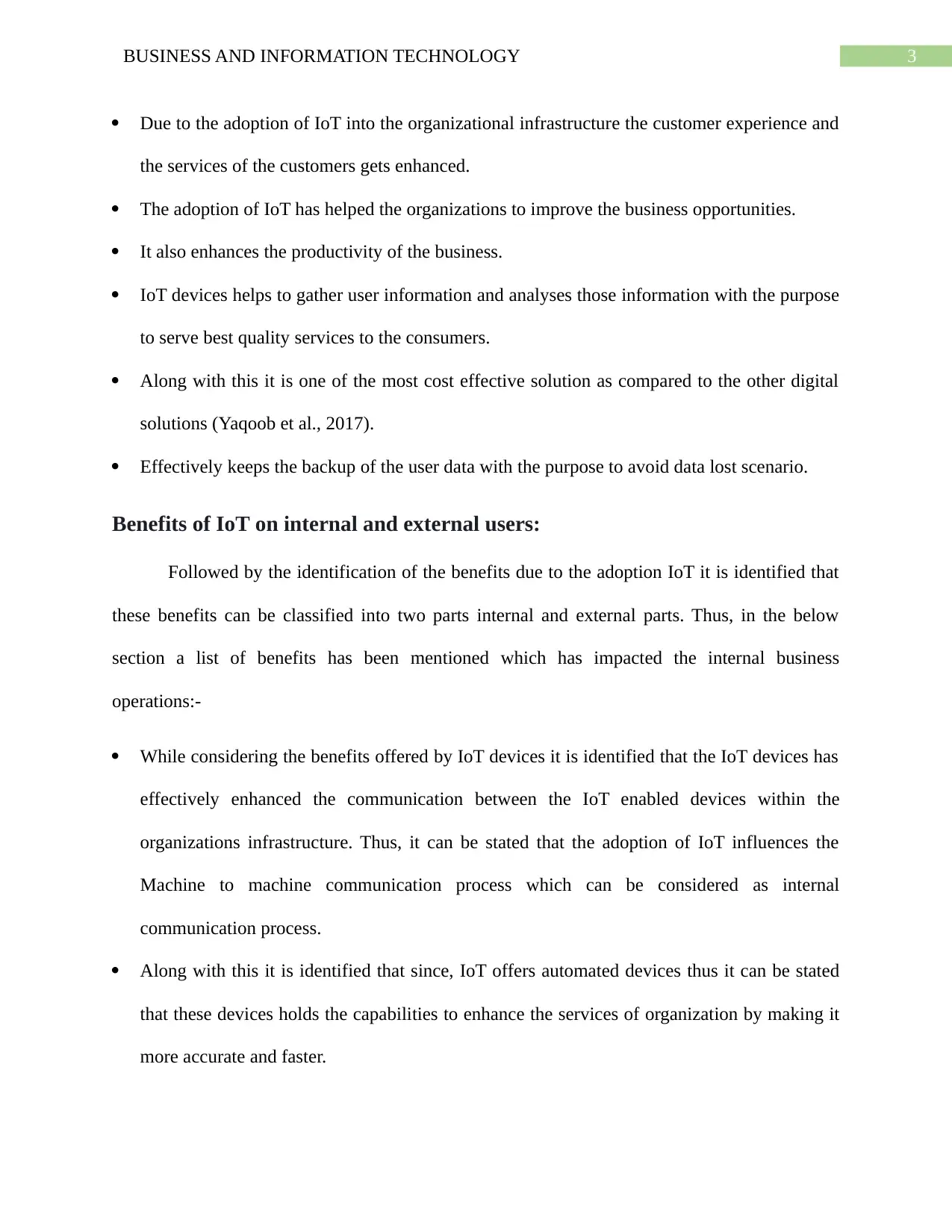
3BUSINESS AND INFORMATION TECHNOLOGY
Due to the adoption of IoT into the organizational infrastructure the customer experience and
the services of the customers gets enhanced.
The adoption of IoT has helped the organizations to improve the business opportunities.
It also enhances the productivity of the business.
IoT devices helps to gather user information and analyses those information with the purpose
to serve best quality services to the consumers.
Along with this it is one of the most cost effective solution as compared to the other digital
solutions (Yaqoob et al., 2017).
Effectively keeps the backup of the user data with the purpose to avoid data lost scenario.
Benefits of IoT on internal and external users:
Followed by the identification of the benefits due to the adoption IoT it is identified that
these benefits can be classified into two parts internal and external parts. Thus, in the below
section a list of benefits has been mentioned which has impacted the internal business
operations:-
While considering the benefits offered by IoT devices it is identified that the IoT devices has
effectively enhanced the communication between the IoT enabled devices within the
organizations infrastructure. Thus, it can be stated that the adoption of IoT influences the
Machine to machine communication process which can be considered as internal
communication process.
Along with this it is identified that since, IoT offers automated devices thus it can be stated
that these devices holds the capabilities to enhance the services of organization by making it
more accurate and faster.
Due to the adoption of IoT into the organizational infrastructure the customer experience and
the services of the customers gets enhanced.
The adoption of IoT has helped the organizations to improve the business opportunities.
It also enhances the productivity of the business.
IoT devices helps to gather user information and analyses those information with the purpose
to serve best quality services to the consumers.
Along with this it is one of the most cost effective solution as compared to the other digital
solutions (Yaqoob et al., 2017).
Effectively keeps the backup of the user data with the purpose to avoid data lost scenario.
Benefits of IoT on internal and external users:
Followed by the identification of the benefits due to the adoption IoT it is identified that
these benefits can be classified into two parts internal and external parts. Thus, in the below
section a list of benefits has been mentioned which has impacted the internal business
operations:-
While considering the benefits offered by IoT devices it is identified that the IoT devices has
effectively enhanced the communication between the IoT enabled devices within the
organizations infrastructure. Thus, it can be stated that the adoption of IoT influences the
Machine to machine communication process which can be considered as internal
communication process.
Along with this it is identified that since, IoT offers automated devices thus it can be stated
that these devices holds the capabilities to enhance the services of organization by making it
more accurate and faster.
Paraphrase This Document
Need a fresh take? Get an instant paraphrase of this document with our AI Paraphraser
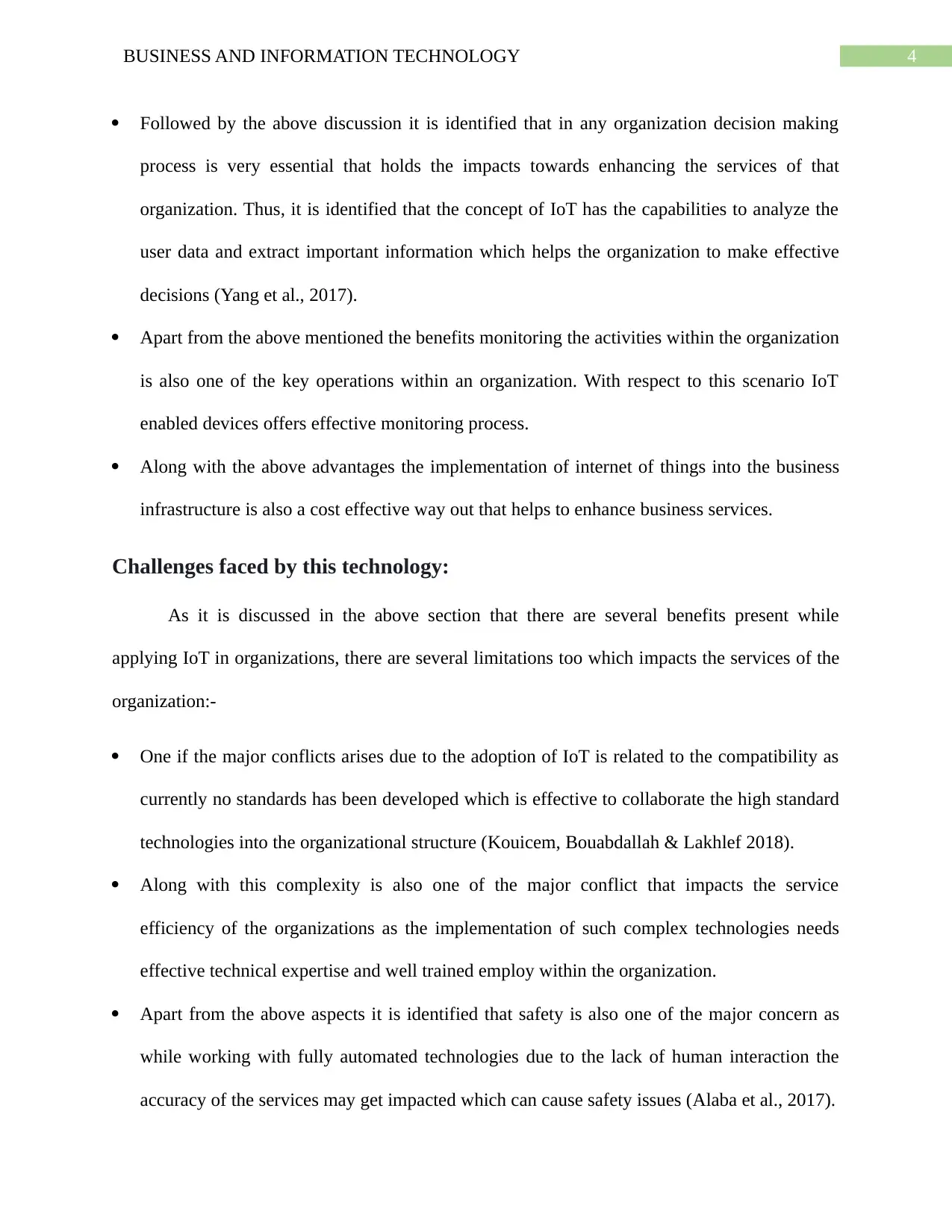
4BUSINESS AND INFORMATION TECHNOLOGY
Followed by the above discussion it is identified that in any organization decision making
process is very essential that holds the impacts towards enhancing the services of that
organization. Thus, it is identified that the concept of IoT has the capabilities to analyze the
user data and extract important information which helps the organization to make effective
decisions (Yang et al., 2017).
Apart from the above mentioned the benefits monitoring the activities within the organization
is also one of the key operations within an organization. With respect to this scenario IoT
enabled devices offers effective monitoring process.
Along with the above advantages the implementation of internet of things into the business
infrastructure is also a cost effective way out that helps to enhance business services.
Challenges faced by this technology:
As it is discussed in the above section that there are several benefits present while
applying IoT in organizations, there are several limitations too which impacts the services of the
organization:-
One if the major conflicts arises due to the adoption of IoT is related to the compatibility as
currently no standards has been developed which is effective to collaborate the high standard
technologies into the organizational structure (Kouicem, Bouabdallah & Lakhlef 2018).
Along with this complexity is also one of the major conflict that impacts the service
efficiency of the organizations as the implementation of such complex technologies needs
effective technical expertise and well trained employ within the organization.
Apart from the above aspects it is identified that safety is also one of the major concern as
while working with fully automated technologies due to the lack of human interaction the
accuracy of the services may get impacted which can cause safety issues (Alaba et al., 2017).
Followed by the above discussion it is identified that in any organization decision making
process is very essential that holds the impacts towards enhancing the services of that
organization. Thus, it is identified that the concept of IoT has the capabilities to analyze the
user data and extract important information which helps the organization to make effective
decisions (Yang et al., 2017).
Apart from the above mentioned the benefits monitoring the activities within the organization
is also one of the key operations within an organization. With respect to this scenario IoT
enabled devices offers effective monitoring process.
Along with the above advantages the implementation of internet of things into the business
infrastructure is also a cost effective way out that helps to enhance business services.
Challenges faced by this technology:
As it is discussed in the above section that there are several benefits present while
applying IoT in organizations, there are several limitations too which impacts the services of the
organization:-
One if the major conflicts arises due to the adoption of IoT is related to the compatibility as
currently no standards has been developed which is effective to collaborate the high standard
technologies into the organizational structure (Kouicem, Bouabdallah & Lakhlef 2018).
Along with this complexity is also one of the major conflict that impacts the service
efficiency of the organizations as the implementation of such complex technologies needs
effective technical expertise and well trained employ within the organization.
Apart from the above aspects it is identified that safety is also one of the major concern as
while working with fully automated technologies due to the lack of human interaction the
accuracy of the services may get impacted which can cause safety issues (Alaba et al., 2017).
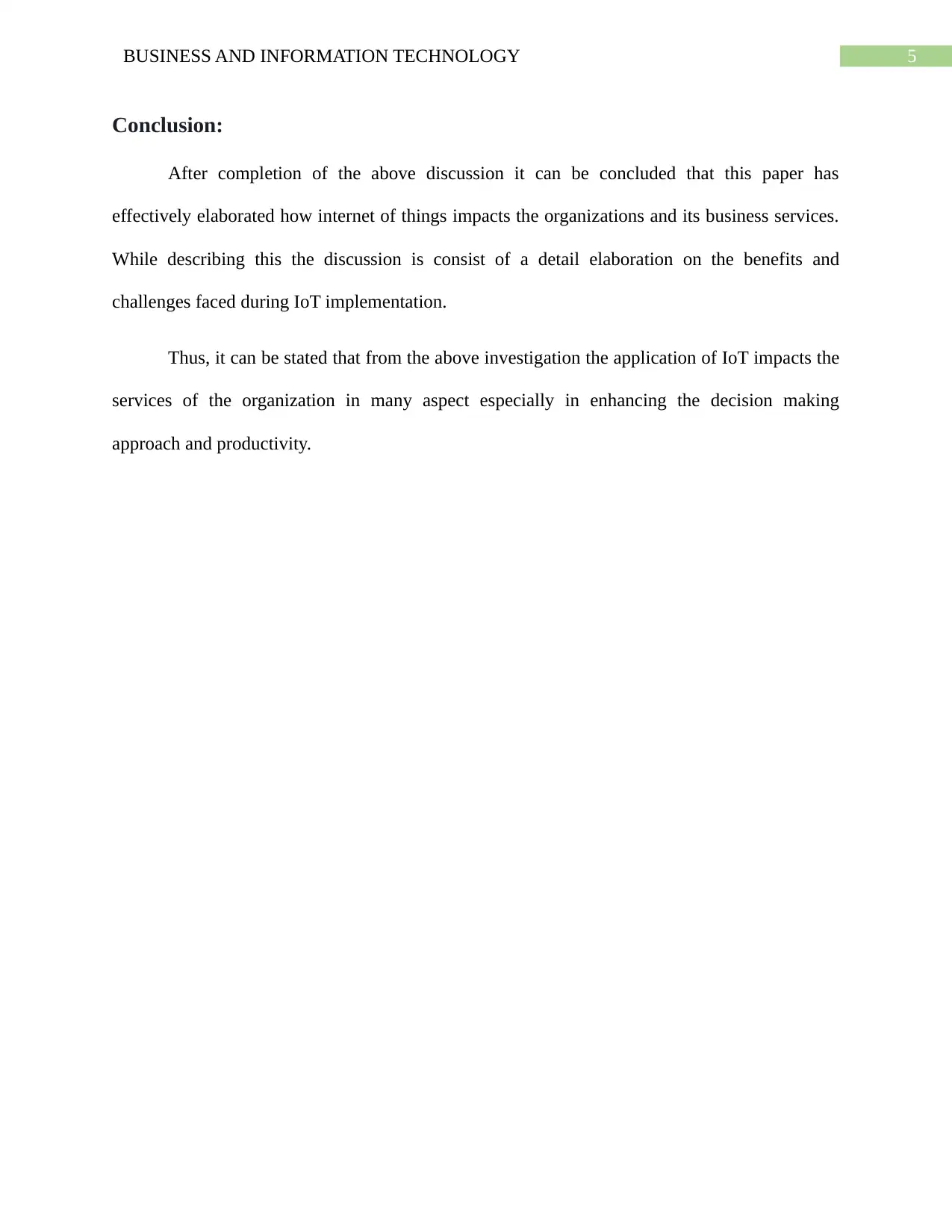
5BUSINESS AND INFORMATION TECHNOLOGY
Conclusion:
After completion of the above discussion it can be concluded that this paper has
effectively elaborated how internet of things impacts the organizations and its business services.
While describing this the discussion is consist of a detail elaboration on the benefits and
challenges faced during IoT implementation.
Thus, it can be stated that from the above investigation the application of IoT impacts the
services of the organization in many aspect especially in enhancing the decision making
approach and productivity.
Conclusion:
After completion of the above discussion it can be concluded that this paper has
effectively elaborated how internet of things impacts the organizations and its business services.
While describing this the discussion is consist of a detail elaboration on the benefits and
challenges faced during IoT implementation.
Thus, it can be stated that from the above investigation the application of IoT impacts the
services of the organization in many aspect especially in enhancing the decision making
approach and productivity.
⊘ This is a preview!⊘
Do you want full access?
Subscribe today to unlock all pages.

Trusted by 1+ million students worldwide
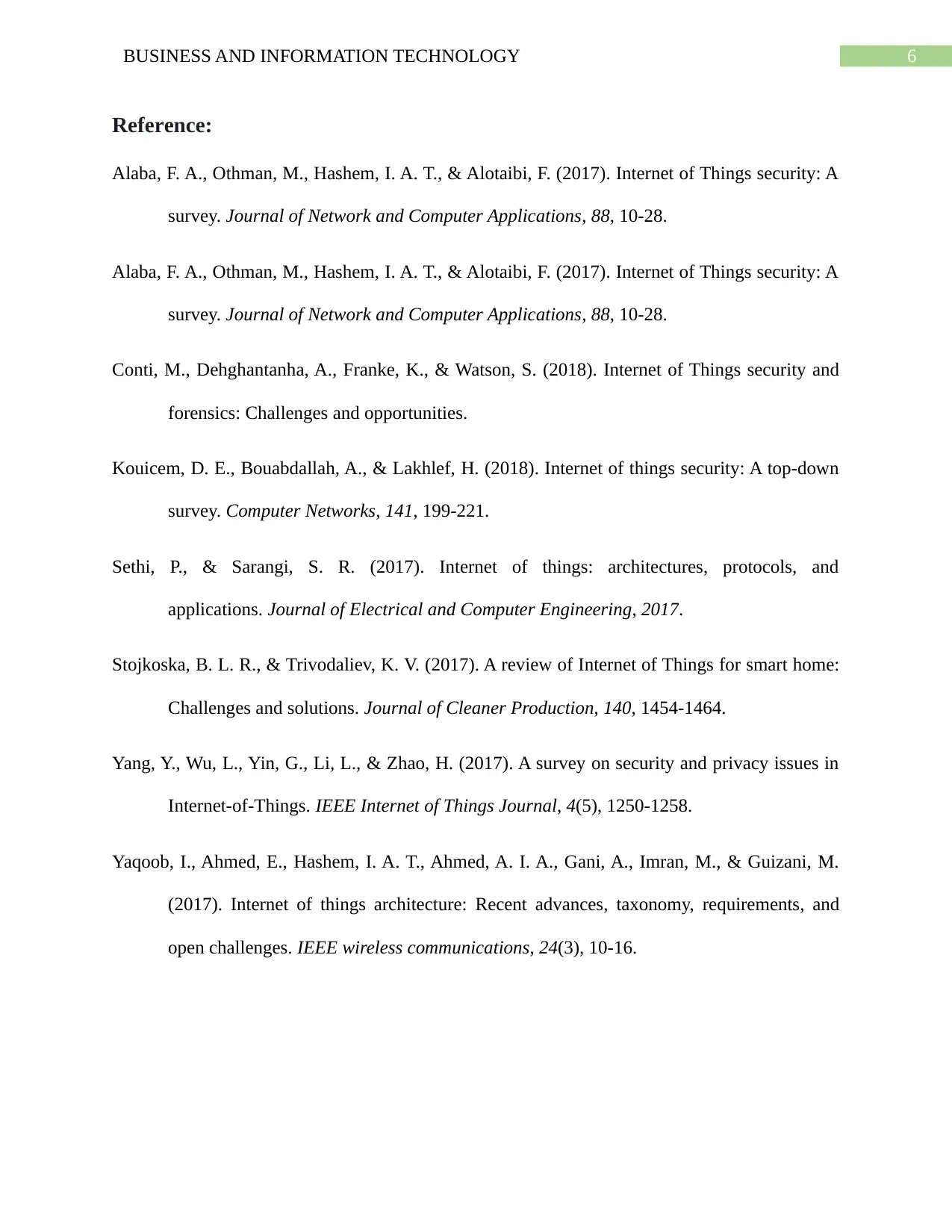
6BUSINESS AND INFORMATION TECHNOLOGY
Reference:
Alaba, F. A., Othman, M., Hashem, I. A. T., & Alotaibi, F. (2017). Internet of Things security: A
survey. Journal of Network and Computer Applications, 88, 10-28.
Alaba, F. A., Othman, M., Hashem, I. A. T., & Alotaibi, F. (2017). Internet of Things security: A
survey. Journal of Network and Computer Applications, 88, 10-28.
Conti, M., Dehghantanha, A., Franke, K., & Watson, S. (2018). Internet of Things security and
forensics: Challenges and opportunities.
Kouicem, D. E., Bouabdallah, A., & Lakhlef, H. (2018). Internet of things security: A top-down
survey. Computer Networks, 141, 199-221.
Sethi, P., & Sarangi, S. R. (2017). Internet of things: architectures, protocols, and
applications. Journal of Electrical and Computer Engineering, 2017.
Stojkoska, B. L. R., & Trivodaliev, K. V. (2017). A review of Internet of Things for smart home:
Challenges and solutions. Journal of Cleaner Production, 140, 1454-1464.
Yang, Y., Wu, L., Yin, G., Li, L., & Zhao, H. (2017). A survey on security and privacy issues in
Internet-of-Things. IEEE Internet of Things Journal, 4(5), 1250-1258.
Yaqoob, I., Ahmed, E., Hashem, I. A. T., Ahmed, A. I. A., Gani, A., Imran, M., & Guizani, M.
(2017). Internet of things architecture: Recent advances, taxonomy, requirements, and
open challenges. IEEE wireless communications, 24(3), 10-16.
Reference:
Alaba, F. A., Othman, M., Hashem, I. A. T., & Alotaibi, F. (2017). Internet of Things security: A
survey. Journal of Network and Computer Applications, 88, 10-28.
Alaba, F. A., Othman, M., Hashem, I. A. T., & Alotaibi, F. (2017). Internet of Things security: A
survey. Journal of Network and Computer Applications, 88, 10-28.
Conti, M., Dehghantanha, A., Franke, K., & Watson, S. (2018). Internet of Things security and
forensics: Challenges and opportunities.
Kouicem, D. E., Bouabdallah, A., & Lakhlef, H. (2018). Internet of things security: A top-down
survey. Computer Networks, 141, 199-221.
Sethi, P., & Sarangi, S. R. (2017). Internet of things: architectures, protocols, and
applications. Journal of Electrical and Computer Engineering, 2017.
Stojkoska, B. L. R., & Trivodaliev, K. V. (2017). A review of Internet of Things for smart home:
Challenges and solutions. Journal of Cleaner Production, 140, 1454-1464.
Yang, Y., Wu, L., Yin, G., Li, L., & Zhao, H. (2017). A survey on security and privacy issues in
Internet-of-Things. IEEE Internet of Things Journal, 4(5), 1250-1258.
Yaqoob, I., Ahmed, E., Hashem, I. A. T., Ahmed, A. I. A., Gani, A., Imran, M., & Guizani, M.
(2017). Internet of things architecture: Recent advances, taxonomy, requirements, and
open challenges. IEEE wireless communications, 24(3), 10-16.
1 out of 7
Related Documents
Your All-in-One AI-Powered Toolkit for Academic Success.
+13062052269
info@desklib.com
Available 24*7 on WhatsApp / Email
![[object Object]](/_next/static/media/star-bottom.7253800d.svg)
Unlock your academic potential
Copyright © 2020–2025 A2Z Services. All Rights Reserved. Developed and managed by ZUCOL.




